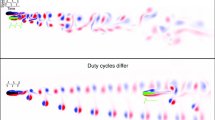Abstract
This paper explores the energy-saving advantages of the burst-and-glide swimming and compares it with the normal self-swimming for a thunniform swimmer. The virtual swimmer allows us to perform controlled numerical experiments by varying the swinging tail number and the duty cycle while keeping the other parameters fixed. 3-D Navier-Stokes equations are used to compute the viscous flow over the swimmer. The user-defined functions and the dynamic mesh technology are used to simulate the burst-and-glide swimming. The results show that with the increase of the swinging tail number or the duty cycle, the swimming velocity, the power and the efficiency all increase, but the velocity-power ratio decreases somewhat. Therefore, choosing smaller swinging tail number and duty cycle is beneficial in reducing the power and increasing the velocity-power ratio, and thus to obtain the same velocity, less power is consumed. And to swim the same distance, the energy can significantly be saved. The power consumption, the efficiency and the velocity-power ratio in the burst-and-glide case are 43.9%, 40.6% and 1.15 times of those in the normal swimming case, respectively. The flow structures clearly show the evolution process around the fish in the burst-and-glide swimming. The findings can be used to reasonably plan the swimming action and to take the advantage of the external flow field energy for the fishlike robot, to be more efficient and energy-saving.
Similar content being viewed by others
References
Takagi T., Tamura Y., Weihs D. Hydrodynamics and energy-saving swimming techniques of pacific Bluefin tuna [J]. Journal of Theoretical Biology, 2013, 336(5): 158–172.
Ribak G., Weihs D., Arad Z. Submerged swimming of the great phalacorax carbo sinensis is a variant of the burstand-glide gait [J]. Journal of Experimental Biology, 2005, 208(20): 3835–3849.
Shoele K., Zhu Q. Drafting mechanisms between a dolphin mother and calf [J]. Journal of Theoretical Biology, 2015, 382(10): 363–377.
Ribak G., Weihs D., Arad Z. Consequences of buoyancy to the maneuvering capabilities of a foot-propelled aquatic predator, the great cormorant (phalcrocorax carbo sinensis) [J]. Journal of Experimental Biology, 2008, 211(18): 3009–3019.
Fish F. E., Murray M. M. Hydrodynamic flow control in marine mammals [J]. Integrative and Comparative Biology, 2008, 48(6): 788–800.
Yang Y., Wu G. H., Yu Y. L. et al. Two-dimensional self-propelled fish motion in medium: an integrated method for deforming body dynamics and unsteady fluid dynamics [J]. Chinese Physics Letters, 2008, 25(2): 597–600.
Chueng M. H. On burst-and-glide swimming performance in fishlike locomotion [J]. Bioinspiration and Biomimetics, 2009, 4(3): 1–12.
Muller U. K., Boogaart J. G. M., Leeuwen J. V. L. Flow patterns of larval fish: undulatory swimming in the intermediate flow regime [J]. Journal of Experimental Biology, 2008, 211(2): 196–205.
Wu G. H., Yang Y., Zeng L. J. Kinematics, hydrodynamics and energetic advantages of burst-and-glide swimming of koi carps(Cyprinus carpio koi) [J]. Journal of Experimental Biology, 2007, 210(12): 2181–2191.
Fish F. E., Legac P., Williams T. M. Measurement of hydrodynamic force generation by swimming dolphins using bubble DPIV [J]. Journal of Experimental Biology, 2014, 217(2): 252–260.
Alben S., Miller L. A., Peng J. Efficient kinematics for jet-propelled swimming [J]. Journal of Fluid Mechanics, 2013, 733: 100–133.
Quinn D. B., Lauder G. V., Smits A. J. Scaling the propulsive performance of heaving flexible panels [J]. Journal of Fluid Mechanics, 2014, 738: 250–267.
Leftwich M. C., Tytell E. D., Cohen A. H. Wake structures behind a swimming robotic lamprey with a passively flexible tail [J]. Journal of Experimental Biology, 2012, 215(3): 416–425.
Battista N. A., Baird A. J., Miller L. A. A mathematical model and MATLAB code for muscle-fluid-structure simulations [J]. Integrative and Comparative Biology, 2015, 55(5): 901–911.
Xia D., Chen W., Liu J. et al. The three-dimensional hydrodynamics of thunniform swimming under self-propulsion [J]. Ocean Engineering, 2015, 110: 1–14.
Bottom R. G., Borazkani I., Blevins E. L. et al. Hydrodynamics of swimming in stingrays: Numerical simulations and the role of the leading-edge vortex [J]. Journal of Fluid Mechanics, 2016, 788: 407–443.
Zhu Q., Shoele K. Propulsion performance of a skeleton strengthened fin [J]. Journal of Experimental Biology, 2008, 211(13): 2087–2100.
Borazkani I., Sotiropoulos F. On the role of form and kinematics on the hydrodynamics of self-propelled body/ caudal fin swimming [J]. Journal of Experimental Biology, 2010, 213(1): 89–107.
Calovi D. S., Litchinko A., Lecheval V. et al. Disentangling and modeling interactions in fish with burst-and-coast swimming reveal distinct alignment and attraction behaviors [J]. Plos Computational Biology, 2018, 14(1): 1–28.
Shoele K., Zhu Q. Leading edge strengthening and the propulsion performance of flexible ray fins [J]. Journal of Fluid Mechanics, 2012, 693: 402–432.
Xia D., Chen W. S., Liu J. K. et al. Using spanwise flexibility of caudal fin to improve swimming performance for small fishlike robots [J]. Journal of Hydrodynamics, 2018, 30(5): 859–871.
Schultz W. W. Power Requirements of swimming: Do new methods resolve old questions? [J. Integrative and Comparative Biology, 2002, 42(5): 1018–1025.
Yuan H. T., Hu W. R. A numerical study of tadpole swimming in the wake of a D-section cylinder [J]. Journal of Hydrodynamics, 2017, 29(6): 1044–1053.
Tytell E. D., Lauder G. V. The hydrodynamics of eel swimming–I. Wake structure [J]. Journal of Experimental Biology, 2004, 207(11): 1825–1841.
Neveln I. D., Bale R., Bhalla A. P. S. Undulating fins produce off-axis thrust and flow structures [J]. Journal of Experimental Biology, 2014, 217(2): 201–213.
Acknowledgement
This work was supported by the State Key Laboratory of Robotics and System, Harbin Institute of Technology ( SKLRS-2018-KF-11).
Author information
Authors and Affiliations
Corresponding author
Additional information
Project supported by the National Natural Science Foundation of China (Grant Nos. 51875101, 51375085).
Biography: Dan Xia (1982-), Male, Ph. D., Associate Professor
Rights and permissions
About this article
Cite this article
Xia, D., Chen, Ws., Liu, Jk. et al. The energy-saving advantages of burst-and-glide mode for thunniform swimming. J Hydrodyn 30, 1072–1082 (2018). https://doi.org/10.1007/s42241-018-0120-8
Received:
Revised:
Accepted:
Published:
Issue Date:
DOI: https://doi.org/10.1007/s42241-018-0120-8




